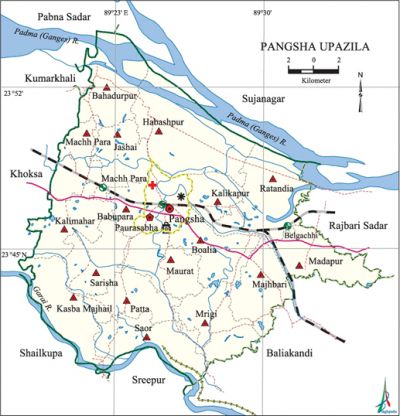Pangsha Upazila
Pangsha Upazila (rajbari district) area 414.24 sq km, located in between 22°40' and 22°55' north latitudes and in between 89°19' and 89°36' east longitudes. It is bounded by sujanagar (pabna) and pabna sadar upazilas on the north, shailkupa and sreepur (magura) upazilas on the south, kalukhali upazilas on the east, khoksa and kumarkhali upazilas on the west.
Population Total 217203; male 112442, female 104761; Muslim 211953, Hindu 25188 and others 62.
Water bodies Main rivers: padma, gorai.
Administration Pangsha Thana was formed in 1863 and it was turned into an upazila in 1984. Municipality was formed in 1990.
| Upazila | ||||||||
| Municipality | Union | Mouza | Village | Population | Density (per sq km) | Literacy rate (%) | ||
| Urban | Rural | Urban | Rural | |||||
|
1 |
10 |
257 |
255 |
29910 |
187293 |
845 |
52.4 |
36.66 |
| Municipality | ||||||||
|
Area (sq km) |
Ward |
Mahalla |
Population |
Density (per sq km) |
Literacy rate (%) | |||
|
12.56 |
9 |
21 |
25078 |
1996 |
56.06 | |||
| Upazila Town | ||||||||
|
Area (sq km) |
Mouza |
Population |
Density (per sq km) |
Literacy rate (%) | ||||
|
3.77 |
6 |
4832 |
1282 |
32.71 | ||||
| Union | ||||
| Name of union and GO code | Area (acre) | Population | Literacy rate (%) | |
| Male | Female | |||
|
Kalimahar 35 |
5099 |
8544 |
8160 |
37.72 |
|
Kasba Majhail 40 |
7256 |
11819 |
11155 |
40.98 |
|
Jashai 25 |
4500 |
9410 |
8663 |
37.43 |
|
Patta 80 |
4879 |
8524 |
7915 |
37.34 |
|
Babupara 75 |
2165 |
6632 |
6162 |
30.90 |
|
Bahadurpur 16 |
5811 |
9773 |
9019 |
35.11 |
|
Machh Para 50 |
5017 |
10405 |
9475 |
37.76 |
|
Maurat 65 |
5602 |
9681 |
9164 |
38.68 |
|
Sarisha 90 |
5237 |
8557 |
8068 |
39.02 |
|
Habaspur 20 |
8752 |
16014 |
14985 |
31.61 |
Source Bangladesh Population Census 2001, Bangladesh Bureau of Statistics.

Archaeological heritage and relics Rathkhola Shanmancha at Belghachhi (18th century), Ferry Fund Road (shaista khan period), Grand Trunk Road.
Historical events Bhairab Babu of Babupara union organised indigo resistance movement in 1860. The khilafat movement, which started in 1920, was widely organised in the area under the leadership of the eminent writer Yakub Ali Chowdhury. During the war of liberation in 1971 the Pak army killed many people of the villages Machh Para, Ramcole and Mathurapur; they also set many houses of these villages on fire.
Marks of the War of Liberation Mass killing site 2 (on the bank of Chandana River adjacent to the Pangsha College).
Religious institutions Mosque 157, temple 110, tomb 8, math 8. Noted religious institutions: Gayebi Mosque, Chhuti Mandal Mosque.
Literacy rate and educational institutions Average literacy 44%; male 43.6%, female 36.2%. Educational institutions: college 10, vocational training centre 3, secondary school 46, primary school 179, satellite school 13, community school 6, madrasa 5. Noted educational institutions: Pangsha College (1969), Pangsha George High School (1919), Ratandia Rajanikanta High School (1920).
Newspapers and periodicals Weekly: Pangsha Barta, Padma; defunct periodical: Kohinoor (1898), Chandana (1972), Nayeb Rasul (1942), Kangal (1925), Protichchhabi (1973).
Cultural organisations Library 4, shilpakala academy 1.
Main sources of income Agriculture 67.97%, non-agricultural labourer 2.87%, industry 0.75%, commerce 11.63%, transport and communication 3.27%, service 5.12%, construction 1.11%, religious service 0.15%, rent and remittance 0.48% and others 6.65%.
Main crops Paddy, jute, sugarcane, betel leaf, sesame.
Extinct or nearly extinct crops Aus paddy.
Main fruits Watermelon, mango.
Fisheries, dairies and poultries Fishery 47, dairy and poultry 270, hatchery 2.
Communication facilities Pucca road 50 km, mud road 540 km; railway 26 km; waterway 40 nautical miles. Railway station 3.
Extinct or nearly extinct traditional transport Palanquin, horse carriage.
Noted manufactories Rice mill, ice factory.
Cottage industries Goldsmith, blacksmith, weaving, bamboo work, cane work, embroidery, wood work, nakshi pakha.
Hats, bazars and fairs Hats and bazars are 6, fairs 3, most noted of which are Bagduli Hat, Pangsha Hat, Habaspur Mela and Shashanbari Mela.
Main exports Jute, molasses, betel leaf.
Access to electricity All the wards and unions of the upazila are under rural electrification net-work. However 12.33% of the dwelling households have access to electricity.
Sources of drinking water Tube-well 94.84%, tap 0.48%, pond 0.39% and others 4.29%.
Sanitation 29.47% (rural 27.32% and urban 54.37%) of dwelling households of the upazila use sanitary latrines and 54.79% (rural 56.31% and urban 35.53%) of dwelling households use non-sanitary latrines; 15.74% of households do not have latrine facilities.
Health centres Upazila health centre 1, union health centre 9, family planning centre 8, clinic 4.
NGO activities Operationally important NGOs are brac, asa. [Md. Tawhid Mia]
References Bangladesh Population Census 2001, Bangladesh Bureau of Statistics; Cultural survey report of Pangsha Upazila 2007.
